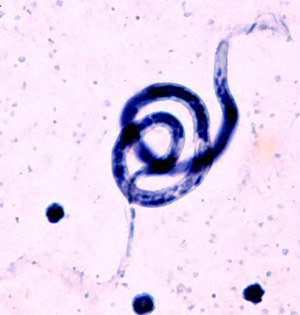Brugia malayi
| Brugia malayi | ||||||||||||
|---|---|---|---|---|---|---|---|---|---|---|---|---|

Brugia malayi |
||||||||||||
| Systematics | ||||||||||||
|
||||||||||||
| Scientific name | ||||||||||||
| Brugia malayi | ||||||||||||
| ( Brug , 1927) |
Brugia malayi is a tropical nematode belonging to the filaria group . It parasitizes humans and can cause lymphatic filariasis and the clinical picture of elephantiasis .
features
The adult worms have the elongated structure typical of roundworms. They are up to 2.5 cm (males) or 6 cm (females) long.
The larvae (microfilariae, larvae 3) are 200-300 µm in size and have a shell that is already over the egg and is only dissolved in the digestive tract of the infected insect. They also circulate in this form in the human bloodstream.
distribution
Brugia malayi is a tropical disease that is found in Southeast Asia . The main settlement areas are India and China, other affected countries are Indonesia, Thailand, Malaysia, the Philippines and Vietnam.
Life cycle
It is transmitted by mosquitoes of the Aedes , Culex , Anopheles and Mansonia species .
The adult filariae sit in the lymphatic vessels, where enveloped microfilariae are formed (over a short egg stage). The microfilariae - especially those from infections in the area of open swamp areas and rice fields - are subject to a daily rhythm : At night they are distributed in the blood and can thus be spread by blood-sucking insects; During the day, as a result of the increased oxygen content, they accumulate in the small vessels of the lungs. The greatest number of microfilariae can be detected in the blood between midnight and 2 a.m. In swamp forests , however, there can also be variants that are spread in the blood during the day.
In the mosquito's digestive system, the covering around the microfilariae dissolves. With the help of a chitinase activity , they can leave the midgut and establish themselves in the thorax . There the L1 (larva 1) develops. From the L1 the L3 (larva 3) emerges, which settles in the mosquito's salivary gland. The number of microfilariae that reach the L3 stage in the insect is very low, so a single sting is not enough to infect the vertebrate host (humans, house cats, etc.). In addition, only around 10% of L3 develop into an adult worm that can lodge in the lymphatic vessels. The development of infectious larvae in the mosquitoes requires high temperatures and humidity. After an infection, the filariae settle in the lymphatic system . The adult worms release microfilariae after about 3 months. The circle closes when the microfilariae are picked up by another mosquito bite. The adult worms can survive in the host for 5 to 15 years.
Systematics
Brugia malayi was first delimited in 1927 from Lichtenstein and Brug within the Filaria and described as Filaria malayi . Previously, they were counted as due to their similarity to Wuchereria bancrofti . This delimitation was based on the microfilariae (the larval stage) of the roundworms. This hypothesis only found general acceptance when Rao and Maplestone found two specimens of the adult worm in India, which differed from Wuchereria bancrofti , in the 1940s . They described the new species as Wuchereria malay .
The current division into the two genera Wuchereria and Brugia comes from the parasitologist JS Buckley.
literature
- Fritz H. Kayer: Pocket textbook medical microbiology. 13th, completely revised and expanded edition, Thieme, Stuttgart 2014, ISBN 978-3-13-444813-9 .
Individual evidence
- ^ A b David T. John, William A. Petri: Markell and Voge's Medical Parasitology. 9th edition, Saunders Elsevier, St. Louis 2006.
- ↑ Ralf Bialek, Rüdiger W. Braun, Burchard-Fröhlich-Eckhart-Nothdurft: Travel and Tropical Medicine: Course book for further training, practice and advice. Schattauer, Stuttgart 2005, ISBN 3-7945-2286-9 .
- ^ F. Hawking: The 24-hour periodicity of microfilariae: biological mechanisms responsible for its production and control. In: Proceedings of the Royal Society B. Volume 169, No. 1014, 1967, doi: 10.1098 / rspb.1967.0079
- ^ A b J. FB Edeson, T. Wilson: The epidemiology of filariasis due to Wuchereria Bancrofti and Brugia Malayi. In: Annual Review Entomology. 1964.
- ↑ P. Fischer, SM Erickson, K. Fischer, JF Fuchs, RU Rao, BM Christensen, GJ Weil: Persistence of Brugia Malayi DNA in vector and non-vector mosquitoes: implication for xenomonitoring and transmission monitoring of lymphatic filariasis. In: American Journal of Tropical Medicine Hygiene. Volume 76, No. 3, 2007, pp. 502-507.
- ↑ Manabu Sasa: A review on classification and geographic distribution on brugian filariasis. ( PDF; 473 kB ( Memento of the original from June 4, 2011 in the Internet Archive ) Info: The archive link has been inserted automatically and has not yet been checked. Please check the original and archive link according to the instructions and then remove this notice. ) Joint WPRO / SEARO Working Group on Brugian Filariasis. WHO World Health Organization 1979.
- ↑ Liu Shiyung: Filaria and plasmodium: distribution of endemic diseases and western plain exploitation in Taiwan. ( PDF; 1.3 MB ) XIV International Economic History Congress, Helsinki 2006, Session 46.
